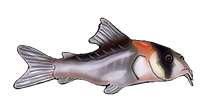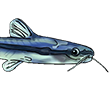I didn't quite know where to put this:
This is something that was send to me by someone living in Brasil and that would like to stay Anonymus:
I know it is a long message but I guess it explains quite well what has been going on there and what future might reserve us...Historically, the policy of Brazilian Government regarding ornamental fish was to allow the trade of all species, except those from a negative list of a few species used as human food. That period (which ended in 1989) was ruled by a now extinct governmental department named SUDEPE (Superintendência do Desenvolvimento da Pesca). As its own name reveals, it was a department aiming mainly the DEVELOPMENT (desenvolvimento) of fisheries (pesca).
Precisely in 1989, Sudepe has been extinct, as well as IBDF (Instituto Brasileiro de Desenvolvimento Florestal, a very restrictive flora and fauna department), and both (as well as two other smaller governmental departments) joined in a bigger, much more restrictive (than Sudepe) department, named IBAMA (Instituto Brasileiro de Meio Ambiente e Recursos Naturais Renováveis).
The first decision of the new IBAMA regarding ornamental fish fisheries was to replace Sudepeâ??s policy of negative list, by a POSITIVE list. In other words, Sudepe used to allow the trade of all but (letâ??s say) 20 species in a negative list; Ibama changed this policy to FORBID all fish species, but only 45 species plus 5 genera (Ancistrus sp., Peckoltia sp., Corydoras sp., Otocinclus sp. and Hyphessobrycon sp.). That 1989 positive list is namely Portaria nº 1.533 of 20th December 1989.
Almost three monthslater, the same Ibama enlarged the positive list to 79 species, plus 7 genera (keeping the inclusion of Ancistrus and Peckoltia). This positive list is namely Portaria nº 477 of 14th March 1990.
In 1992, Ibama again enlarged this positive list to 174 species, plus 3 genera (Portaria 62-N of 10th June 1992), which received the addition of two species plus one genera (Portaria nº 80 of 27th July 1994). So, still today, this legislation is valid, meaning that only 174 fish species plus four genera (Ancistrus, Peckoltia, Hyphessobrycon and Farlowella) are allowed to be traded (and of course exported).
For your reference, check the following address to read which species are allowed by Brazilian government:
http://www.petsite.com.br/pxlegisla4.asp
Well, now letâ??s go back to the colorful Loricariids, the famous DATZâ?? L-codes. As you know, they began to be discovered in 1986, first in Tocatins-Araguaia basin, then in Xingu basin, Negro basin, lately in Tapajos basin etc. Those fishes are known (by local fishermen) in Brazil by names like amarelo (L18, L81, L177), aba laranja (L47), bola azul (L30, L31), picota (L4, L28, L73), cara chata (L17, L67), preto velho (L34), picota ouro (L14), pinima (L7, L29), tigre (L2, L38, L74), picota preta (L86) etc. As you know, all those fishes are Ancistrinae, and in 1989 (year of the first Ibama positive list) were all identified as Ancistrus sp. or Peckoltia sp. So all included on that positive list.
Also in 1989, Isbrücker and Nijssen described three new genera, that included some of those Ancistrus sp. and/or Peckoltia sp. (Scobinancistrus, Hopliancistrus and Leporacanthicus). In the same year, Lucia Rapp Py-Daniel described more two (Baryancistrus and Oligancistrus). In 1991 Isbrücker and Nijssen described Hypancistrus. And so on in later years (Panaqolus, Ancistomus etc.).
Ibama didnâ??t update the genera names for the L-codes on his sucessive upgradings of 1989 positive list (1990, 1992, 1994) and all those years, from 1989 on, till 2004 has been issuing documents (GUIAS DE TRANSITO) where you can read things like amarelinho (Ancistrus sp.), aba laranja (Peckoltia sp.), cara chata (Ancistrus sp.) etc., for all the L-codes.
With the new Brazilian government, which started in 2002, and the follow of Rio 92 Convencao sobre Diversidade Biologica, which became law in Brazil by several President acts (the first in 1994, latest in 2002), it has been stated that government, scientists and businessmen, all together, must constitute committees and propose new legislations. On that aim, in October 2003, there was a meeting in Brasilia (Brazilâ??s capital city) where is the head office of Ibama, that discussed the out-dating of the scientific names on Portaria 62-N of 10th June 1992. Specifically, the situation was more cryptic on the L-codes, as previously discussed. Ibama, scientists, businessmen and ecologists, in an assembly, discussed it exhaustively, and agreed that (in regard of the L-codes) the undescribed species would continue to be legally traded (under the names Ancistrus sp., Peckoltia sp.), for a period of 3 years (so until 2006), until they were formally scientifically described. This was officially published by Ministerio do Meio Ambiente (MMA), Ibama and CEPNOR (Centro de Pesquisa e Gestao de Recursos Pesqueiros do Litoral Norte) in a document named Relatorio da Reuniao Tecnica sobre a Pesquisa e Ordenamento da Pesca de Peixes Ornamentais na Regiao Norte do Brasil.
So, as you see, everything was absolutely clear and solved. Until export cargos of three companies in Manaus (*****, ****** and ********) was stopped (after being checked by Ibama and authorized to be delivered) by Brazilian Federal Police, retained, examined by an expert (?), actually a junior student of Universidade do Amazonas (***** ****) that insisted that the cargo was illegal, because it contained fish labeled as Ancistrus sp., Peckoltia sp., that were indeed Baryancistrus, Hypancistrus and so on. All the cargo was sent to a research institution, Inpa (Instituto Nacional de Pesquisas da Amazonia), where they were checked by Lucia Py-Daniel that of course identified amarelinhos & Co. as Baryancistrus, Hypancistrus etc.
That story (in Manaus) still involves a series of other dirt trials to incriminate the fish companies, but it would be too long to explain them here. The fact is that they got lawyers, and are well defended (legally). But the immediate decision of all (or most) Manaus company was to stop totally to export all L-codes that are not strictly (in the current knowledge of ichthyology) Ancistrus or Peckoltia. Some companies in other parts of Brazil (Belem, Recife, Sao Paulo etc.) continued to export the L-codes, based on all above facts, and also in a official opinion of some Ibama departments (in some States, but not the head office of Ibama in Brasilia).
Much more is going on, regarding a negative list, published not by Ibama, but by MMA (Ministerio do Meio Ambiente), that has forbidden 156 fish species to be collected, traded or even bred (!!!) in Brazil, including fish like Hypancistrus zebra, Gramma brasiliensis and Elacatinus figaro. Regarding marine fish, after 15 years of negative list, Ibama radically acted, restricting the exports to a Positive List, each fish with a very limited share per company (from 500 to 1000 species, per fish species per company).
Now there are rumors regarding the new Positive List (to be published) on freshwater fishes, not very pleasant to aquarium fish business...
All that situation led to the foundation of a National Association of aquarium companies, named ABREA, through a meeting in Brasilia, this month. A lawyer has been named, and will fight for fair rules regarding aquarium fish business. As it is the feeling among the members that Brazilian Government is doing much against fish collecting (or even against fish breeding) and not doing enough against fish biotopes destruction. For example, they have included H. zebra in an extinction list, forbid its trade or breeding, but the area where this species occurs (Rio Xingu down from Altamira) will be totally flooded by a hydroelectric dam (Altamira dam) of Eletronorte (North Brazilian Electric Energy Company). So, it looks like a governmental show off, against the weaker operations, instead of attacking the big Nature destroyers.
Cheers
Yann




